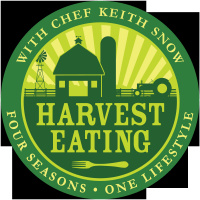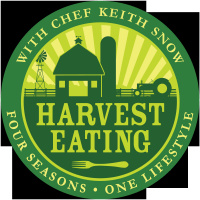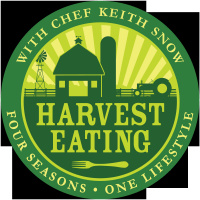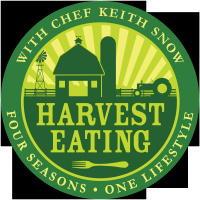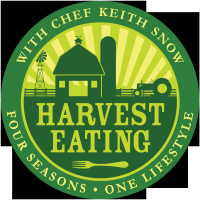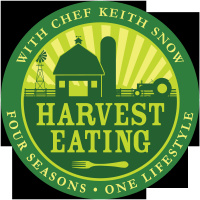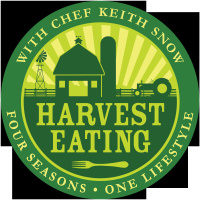Harvest Eating Podcast-plant Based Vegan Recipes
- Autor: Vários
- Narrador: Vários
- Editora: Podcast
- Duração: 327:00:16
- Mais informações
Informações:
Sinopse
The Harvest Eating vegan podcast is dedicated to plant-based vegan cooking and lifestyle. Discover new whole foods plant-based vegan recipes ideas, new ingredients and cooking techniques focused on a healthy plant based vegan lifestyle.
Episódios
-
488-A Dream Homestead From A Chef's Perspective
08/03/2023 Duração: 57minVisit Harvest Eating Today I wanted to muse about what I would consider the perfect homestead in regard to what could be grown, raised, and eventually preserved or butchered and eaten. This is a complicated topic but one I find useful to discuss as it gets us thinking about what might be important to incorporate into an existing or future homestead as in my case. For me, a homestead is a place that creates much-needed peace and security as well as enjoyable spaces to relax and be in nature. A place that can produce life-giving foods that meet my standards of quality and are free from toxic chemicals, additives, and preservatives. It’s a place where culinary arts meet home economics and the two pursuits thrive together. Determining what I want my family to eat starts the whole process that eventually determines where the property might be and what features such as south-facing land, soil quality, rainfall, length of the growing season, available water, and ability to raise certain animals (no HOA) and cer
-
487-The Power of Electrolytes-My Story
22/02/2023 Duração: 31minVisit Harvest Eating Now! When it comes to electrolytes I did not know very much until about 8 mos ago. You’d think with my athletic background which spanned the gamut from decades of ice hockey at a serious level, tennis, mountain biking, and even mountain bike racing that I would be familiar with electrolytes, but no. Aside from Gatorade which I hate, I really was not aware that average people, or anyone not a paid athlete, can benefit from electrolyte consumption. I followed the “health experts” who said to drink 8 glasses of water each day, more if you’re sweating, but they were always demonizing salts in every form. Remember a low-sodium, low-fat, and plant-based diet is best…! We’ve all heard this nonsense from the FDA on sodium intake, I think it’s crap. I even listened to my own doctors who pretty much caused an electrolyte deficiency by prescribing medications that cause fluid and mineral loss and then double-downed with advice to take other prescriptions to help with symptoms caused by the prior m
-
486-Make it Yourself-Flour Tortillas
15/02/2023 Duração: 25minShow note and recipe here In my Make It Yourself series I will show (tell) you how to make common items at home instead of buying them and ingesting seed oils etc. Today I will be talking about tortillas, flour tortillas mostly, but I will touch on corn tortillas also. Flour tortillas are very inexpensive and easy to make plus they can be frozen for later use making it a worthwhile project to explore. Ingredients are simple, flour, salt, lard, that’s it! Juxtoppose to the leading brand Mission which contains 20 plus ingredients, including seed oils Resources: https://www.missionfoods.com/products/tortillas/flour-tortillas/ Danish Dough Whisk-https: https://amzn.to/3S369ej. NOT AN AFFILIATE LINK
-
485-Sharpening Your Kitchen Knives
07/02/2023 Duração: 28minVisit Harvest Eating Today I am talking about the task of keeping kitchen knives sharp, which is a very important safety and efficiency practice. Let’s be clear, dull knives are dangerous! Many people feel sharp knives are dangerous but they are much safer than attempting to use a dull knife for cutting food. While many devices and contraptions exist to keep knives sharp many are hard to use, even for pros. I have been around kitchen knives since age 14 and likely spend 5-10 hours per week cutting, chopping, butchering, carving, etc. with said knives. I believe I own several thousand dollars worth of chef’s knives and my drawer is loaded with knives of all types. Because of my work in culinary media, I have been fortunate to try and use the most expensive knives at no cost to me. My collection includes knives from” Cutco ( I served on their culinary advisory board for two years) Mac Wusthof Henckels Global MT Knives Shun to name a few…. All of these knives are pretty darn useless once dull. T
-
484-Making Salsa Verde and Chipotle Salsa
01/02/2023 Duração: 37minLink to today's show In today’s episode, I discuss the wonder that is salsa! Salsa can bring so much flavor, texture, excitement, and utility to your cooking in so many ways. I walk you through a few of my favorite salsas and you will be ready to make them in your own kitchen. The recipes are so easy you really don’t need written instruction. Also, below pls find a video showing one of the most popular salsas, pico de gallo. Enjoy! Links to check out: Support Harvest Eating Join Food Storage Feast Brown Duck Coffee About Chef Keith Snow Some of My Fav Recipes
-
483-Let's Talk About Seed Oils
25/01/2023 Duração: 29minwww.harvesteating.com/podcast-1/483-lets-talk-about-seed-oils Today I discuss the idea that seed oil/ vegetable oil might be bad for us. While the medical authorities and online medical sites tout the “heart-healthy benefits” of polyunsaturated oil like canola, corn, soybean, grape seed, etc. many others (including me) doubt these claims and a groundswell of opposition to seed oils and “vegetable” oils is building. I predict many of your favorite snack foods being cooked in fats such as tallow, duck fat, coconut oil, avocado, and olive oil and marketed to those avoiding seed oils. These nasty oils are everywhere and in everything, you can possibly think of, all snacks, chocolates, cookies, cakes, chips, crackers, dressings, condiments such as mayo, BBQ, marinades, etc. So avoiding them takes some discipline and plenty of label-reading. How did industrial seed oils go from being classified as “toxic waste” to enjoying the title of “heart-healthy” fats? As first documented by Nina Teicholz, in her book, The B
-
482-Bolognese Sauce, A versatile and Delicious Italian Favorite.
17/01/2023 Duração: 22minFind the recipe for today's show at Harvest Eating Bolognese sauce is a classic Italian recipe for meat sauce. Generally, it contains 3 types of ground meat; beef, veal, and pork. Sometimes the cook will substitute other meats such as wild boar, deer, or other game meats. It is a very thick sauce and is not a tomato sauce but rather a meat sauce that has some tomatoes, or not. Bolognese sauce is typically served with a wide noodle like pappardelle, or fettuccini, or even used to fill lasagna. It's classically made using some kind of wine and usually a little milk, or cream and herbs. The are many variations of this dish and they all are wonderful. Recommended Links: Support Harvest Eating Brown Duck Coffee About Chef Keith Snow
-
481-Making Sauce Bordelaise
10/01/2023 Duração: 13minThis simple sauce is easy to make and quite delicious with any type of red meat. In my opinion, it's best with roasted and sliced tri-tip steak. However, any cut will benefit from a little bordelaise sauce to dip in. Basic recipe: 1 large finely minced shallot 4 tbsp good butter 2 cups of drinkable red wine 3-4 tbsp beef stock or demi-glace salt and white pepper to taste Recommended Links: Support Harvest Eating Brown Duck Coffee About Chef Keith Snow Some of My Fav Recipes Resources: https://amzn.to/3vPZDgX. BUY demi-glace https://bordeaux.guides.winefolly.com/regions https://www.merriam-webster.com/dictionary/Bordelaise
-
480-How to Thicken Sauces and Soups
05/01/2023 Duração: 24minVisit Harvest Eating RIGHT NOW! Often times while cooking we run into consistency issues with regard to sauces, soups, and other items. The texture is such a key factor in the enjoyment of food so learning some methods to address consistency is a great skill to have. Whether we use a roux, an egg yolk, butter, a slurry of arrowroot, potato starch, or more “sciencey” items like xanthan gum, affecting texture is the key to better cooking. Here are a few items commonly used to thicken our foods: slurries-cornstarch, arrowroot, potato starch, roux-flour and fat like butter, oil or lard burre manie-a dough of butter and flour egg yolks cooked and pureed potatoes butter Other methods that are common are reducing the liquid volume by simmering uncovered to rid the excess moisture fr oma food. Recommended Links: Support Harvest Eating Brown Duck Coffee About Chef Keith Snow Some of My Fav Recipes Resources for today’s show: https://youtu.be/pxHyPSQAbZU. Make burre manie-kneaded butter https://youtu.be
-
479-Shrimp Cocktail
28/12/2022 Duração: 13minShow Notes On Harvest Eating Shrimp cocktail is a wonderful appetizer that is slightly elegant and a bit luxurious too. It usually is found during special parties, holiday parties and for us, a Christmas eve treat! Making it is not difficult but like many things, takes a bit of know-how. The first part is securing wild-caught shrimp. I personally place a “hard stop” on farm-raise seafood, especially shrimp. I can’t fathom how this nasty industry has become so large when the product is produced in such horrid conditions. Below is a video showing where your farm-raised shrimp comes from: warning..you will be alarmed! For your convenience, I’ve added this link so you can purchase Wild American shrimp and have it shipped to your door. I have no relationship with these folks, FYI. How I make shrimp cocktail, first the poaching or boiling liquid: First, create the liquid they will be poached in by adding 1 gallon cold filtered water to a pot then add the juice of one lemon, with the lemon halves tossed in too, then
-
478-Cabbage Soup w Bacon
22/12/2022 Duração: 22minShow Notes for this episode On today’s show, I want to share the method and basics behind a simple soup made with cabbage and a few other basic ingredients. This cabbage soup takes about 45 minutes or so to put together and is a very satisfying dish. It originates in the Alsace region of France where the German border is close and the mix of culinary cultures blend very well together. This part of France is wonderful to visit and the food culture, area beauty, and friendly people are worth the trip, so I suggest getting there if you can. To make this you'll need the following: 2 heads of cabbage 1 carrot, large 4 garlic cloves 1 large onion, minced cut 1/2 pound smoked bacon, thick cut 64 oz chicken stock salt and pepper to taste In a large pot of salted water add the cabbage that has been quartered, and cook for 10 minutes. Drain and rinse under cold water, remove the core then cup into long thick pieces, and set aside. In the same pot, you boiled the cabbage place over medium-high heat, add butter and
-
477-Culinary Wives' Tales
16/12/2022 Duração: 24minThrough the years I have taught people through this podcast, cookbook, videos, tv shows, magazine articles, and in-person culinary demonstrations many different culinary wives' tales or falsehoods. Stuff I was taught and just always did….because…that’s the way you do it….. As a young chef training under older more experienced chefs, most of them graduates of European or American culinary institutions, I was taught the “way to do things” and little details that I have seen parroted on TV and elsewhere for decades. I’d like to dispel some of them today. A good example of this would be letting meat rest to “reabsorb the juices”. The meat is not reabsorbing juices, the juice is in there and has not gone anywhere….they just are moving fast due to heat. Water is still when cold, but moves when simmering or boiling because the atoms react to heat and create energy. So, when we remove meat from the oven, as it cools the juices are less likely to spill out, but there is no reabsorbing going on. Seasoning meat and thi
-
476-Don't Burn The Christmas Roast
12/12/2022 Duração: 20minVisit Harvest Eating In today's episode, I will discuss a basic technique called the "reverse sear" which is basically a low-temperature process to ensure your meats are more evenly cooked instead of overcooked on the outside and rare inside. If you've ever smoked a pork butt you have used elements of the reverse sear which is low and slow cookery. This method also has the advantage that it lets the vast majority of the cooking time elapse well before service which can allow the home cook to attend to other parts of the meal which can be challenging to time out properly. I STRONGLY suggest the use of a digital probe thermometer which lets you nail the temperatures! Meat is expensive, practice safe meat cookery! You'll want to remove the roast from the refrigerator about 2-3 hours before cooking and season all surfaces with salt. Let sit uncovered until you're ready to place it in the oven. Place the digital probe thermometer into the center of the meat but NOT touching a bone. I would suggest cooking this a
-
475-Creme Fraiche-The Dessert Cream That Anyone Can Make
08/12/2022 Duração: 15minCultured or inoculated creams like Creme Fraiche have been around for a long, long time in many different cultures. The bacterial culture used differentiates them from each other but they are all what I call "cultured cream". In Mexico is called crema, and it's slightly more viscous, here in the USA we have sour cream, across the pond in the UK they have clotted cream (one of my favs) and there are other cultures that have cultured cream too that I won't mention. They are all tasty and useful in culinary applications and just for digging into with your dessert spoon. Today will focus on French-style creme fraiche with is nutty, slightly tangy, and 100% awesome! Before I go too far here is the basic recipe: Ingredients: 1-pint heavy whipping cream or heavy cream, try to find the highest butterfat % you can. 2 tbsp cultured buttermilk Method: Mix these too in a canning jar, place a lid on it and let it sit at room temperature for 18-24 hours, then refrigerate for 3-4 hours. When it chilled it will be amazing.
-
All About Mustard-The Little Seed with Big Flavor and Magical Culinary Uses.
07/12/2022 Duração: 24minMustard is a member of the brassica family of plants and is grown all over the world and is prized in many different cuisines from France to India, Germany, and, of course, The United States of America. The total acres of mustard harvested here in the US was 91,400 acres in 2020. The total production was 81.8 million pounds. The average mustard yield in 2020 was 895 pounds per acre. Mustard is primarily grown in Idaho, Montana, North Dakota, Oregon, and Washington. There are three common mustard seeds, white, yellow, and brown. Yellow mustard is the gold standard for mustards in America. The famous bright yellow color comes from the use of both finely ground yellow mustard seeds and turmeric, a powerful coloring spice. The ground mustard seeds and turmeric are mixed with water and vinegar, and sometimes mild spices, to yield a thick, squeezable condiment. Most yellow mustards start with ground mustard seed or mustard flour. Spicy mustard or deli mustard is usually made with brown mustard seeds, you probably
-
We Face Many Crippling Situations, All At Once!
10/06/2022 Duração: 39minSo many people I speak with say the same thing “ I can’t recognize this country anymore” and I believe they’re right. We currently face so many overlapping challenges that I fear things will get much worse before possibly getting better. I know it’s depressing to think about, but we need to address and face these issues to help get through them together and protect our families and NOT be caught off guard like so many mothers needing infant formula they cannot find. Never before in our history has so much been so wrong at the same time. In 2008 when the great recessions came, we did not have inflation this high or energy prices this high, or a crumbling supply chain. Most of these problems feed off one another. Inflation makes people turn to crime. Empty shelves encourage hoarding and so on. The future has never looked this bleak in my opinion then it does right now. Here is my list of these challenges, in no particular order….. An illegitimate Regime running the government into the ground-killing the econo
-
472-Basic Mayonnaise Recipe
03/06/2022 Duração: 15minShow notes are here! I get a lot of inquiries regarding making mayo or Aoli as it’s also referred to. This is so simple and makes a better product than just about all store-bought mayonnaise. While this is basic, the exact same method can be altered by using flavorings such as garlic, lemon zest, fragrant herbs such as dill, tarragon, basil, thyme, etc. The other point which is important to mention is that just about all commercial mayonnaise is made using GMO mono-crop seed oils which IMO are not the most healthy to eat. There is avocado oil mayo in the market but some (like my family) find it to be off-tasting and not as good as say…Dukes! Save $25 off Food Storage Feast.com membership-save25
-
Out of Stockalypse, CCP Lockdown to Cripple US Critical Industries and Infrastructure.
27/05/2022 Duração: 20minWhile many are focused on the Johnny Depp trial, Monkeypox, or other non-events much of the world, including the United States is entering into what I’ve coined “The Out Of Stockalypse!” Across most industries, American companies large and small are experiencing out of stocks at a rate never before seen in our history. I cannot understate the colossal challenges we are now facing that will be our reality for some time. On March 28th, China locked down the biggest cities and ports in the world under the guise of a Coronavirus outbreak (more on that later) that has crippled global manufacturing and shipping resulting in a critical shortage of parts and materials. The CCP has locked down over 26 million citizens in the most important manufacturing regions in China. Ports in Shanghai, Shenzhen, and Ningbo were shuttered. Since we’re extremely dependent on China to supply everything from prescription drugs to car parts to foodstuffs, to industrial components (pumps, switches, hoses, belts, etc) to plumbing parts,
-
Epi-470-Charleston SC-an Excellent Example Of How Our Food Supply Can Be More Sustainable.
18/05/2022 Duração: 57minShow notes at Keith Snow.com If you have ever visited Charleston SC you quickly realize that among the southern charm and historic buildings there is something else that has visitors flocking to the Holy City. Charleston was founded in 1670 as Charles Town, honoring King Charles 11, and is literally a living history book. Once the heart of the slave trade almost half of all slaves arrived at Charleston, or course this stain on the city’s past should never be forgotten. One of the results of this slave trade was that many slaves from Africa brought their Gullah cuisine and cooking methods with them as well as other traditions such as basket weaving, these recipes, methods, and skills have become a treasure to the Charleston area and all who visit. it Many ingredients that are considered basic commodity staples like rice and corn are now heralded in the Charleston area and have become the stuff of obsession. A reading from Fast Company….The Grit Awakening: Why Antebellum-Style Cornmeal Has Risen Again Tim Mills
-
Are Plants, Seeds And Roots Slowly Killing You?
09/05/2022 Duração: 28minMany of you reading this are aware that some plants contain toxins as well as physical defenses that can injure. Some good examples are rhubarb leaves and wild mushrooms, both of which can make you very ill and possibly kill you. We all should know not to pick mushrooms without either having an expert forager with us or at the very least a field guide that shows which to avoid so you don’t die from poison. Additionally think about very common physical defenses such as thorns on roses, blackberry and raspberry bushes, stinging nettles, cactus, poison ivy, oak, sumac, etc. There is much available evidence to demonstrate that plants do aggressively defend themselves with an arsenal of tools, none of which we enjoy. Even though this is common knowledge most don’t equate plants having thorns or toxins as a way of defending themselves. Rhinos don’t have giant tusks just for show, those are weapons just like antlers, canine teeth, bear claws, etc. But plants don’t growl or run after you, they stay in place and hope


